Bengali Hindus
Bengali Hindus (Bengali: বাঙ্গালী হিন্দু) are an ethnic, linguistic and religious population who make up the majority in the Indian states of West Bengal, Andaman and Nicobar Islands and Tripura. In Bangladesh, they form the largest minority. They are Bengali adherents of Hinduism and are native to the Bengal region in the eastern part of the Indian subcontinent. Bengali Hindus speak Bengali, which belongs to the Indo-Aryan language family and adhere to the Shakta and Vaishnava traditions of their native religion, Hinduism.[9][10] There are significant numbers of Bengali-speaking Hindus in different Indian states.[11][12]
বাঙ্গালী হিন্দু (Bangali Hindu) | |
|---|---|
 The Bengali Hindu Swastika | |
| Total population | |
| c. 78 million | |
| Regions with significant populations | |
| 64,385,546 (2011)[1][2][3] | |
| 12,301,331 (2011)[4] | |
| 450,000[5] | |
| 340,235 | |
| 300,000[6] | |
| 20,500[7] | |
| 10,500[8] | |
| Languages | |
| Bengali | |
| Religion | |
| Hinduism | |
| Part of a series on |
| Bengalis |
|---|
 |
|
Bengali homeland |
|
Bengali culture
|
|
Bengali symbols |
Around the 8th century, the Bengali language branched off from Magadhi Prakrit, a derivative of Sanskrit that was prevalent in the eastern region of the Indian Subcontinent at that time.[13] During the Sena period (11th – 12th century) the Bengali culture developed into a distinct culture within the Hindu civilisation. Bengali Hindus were at the forefront of the Bengal Renaissance in the 19th century. The Bengal region was noted for its participation in the struggle for independence from the British rule.[14][15] At the time of the independence of India in 1947, the province of Bengal was partitioned between India and East Pakistan, part of the Muslim-majority state of Pakistan. Millions of Bengali Hindus numbering around 25,19,557 (1941-1951) have migrated from East Bengal (later Bangladesh) and settled in West Bengal and other states of India. The migration continued in waves through the fifties and sixties, especially during the 1950 East Pakistan genocide in which estimated 4.5 million Hindus migrated to India[16] and during 1964 East-Pakistan riots, an estimated 135,000 Hindus migrated to India[17] In 1971, during the Bangladesh Liberation War, an estimated 2.4 million Bengali Hindus were massacred by the Pakistani army.[18] Estimates for the total number of people killed by Pakistan Army range from 300,000[19] to 3,000,000.[20] The 1971 massacre again led to exodus of millions of Hindus to India.[21]

Ethnonym
The Hindus are a religious group,[22] native to the Indian subcontinent, speaking a broad range of Indo-Aryan and Dravidian languages and adhering to the native belief systems, rooted in the Vedas. The word Hindu is popularly believed to be a Persian exonym for the people native to the Indian subcontinent. The word is derived from Sindhu,[23] the Sanskrit name for the river Indus and it initially referred to the people residing to the east of the river. The Hindus are constituted into various ethno-linguistic subgroups, which in spite of being culturally diverse, share a common bond of unity.
The word Bengali is derived from the Bengali word bangali. The English word Bengali denoting the people as well as the language is derived from the English word Bengal denoting the region, which itself is derived ultimately from the Bengali word Vanga which was one of the five historical kingdoms of Eastern India. According to Harivamsa, Bali, the king of the asuras had five sons from his wife Sudeshna through sage Dirghatama. The five sons namely Anga, Vanga, Kalinga, Pundra and Sumha went on to found five kingdoms of the same name in the eastern region of the Indian subcontinent. In ancient times Vanga proper consisted of the deltaic region between Bhagirathi, Padma and Madhumati, but later on extended to include the regions which now roughly comprise the Indian state of West Bengal and Bangladesh.
In India, they tend to identify themselves as Bengalis[24] while in Bangladesh they tend to identify themselves as Hindus.[25] In the global context, the terms Indian Bengali[26] and Bangladeshi Hindu[27] are respectively used. In India, Bengali generally refers to Bengali Hindus, excluding a significant number of Bengali Muslims who are also ethnically Bengalis.[28] The 'other' is usually identified as 'non-Bengali', a term that generically refers to the Hindu people who are not Bengali speaking, but sometimes specifically used to denote the Hindi speaking population.
Ethnology
The Bengali Hindus constitute of numerous endogamous castes, which are sometimes further subdivided into endogamous subgroups. The caste system evolved over centuries and became more and more complex with time. In the medieval period, several castes were boycotted by the ruling classes from time to time and this isolation continued till the 19th century. These social boycotts were somewhat discriminatory in nature. After the Renaissance, the rigidity of the caste system ceased to a great extent, so much so that the first celebrated intercaste marriage took place as early as in 1925.
The Bengali Hindu families are patriarchal as well as patrilocal and traditionally follow a joint family system. However, due to the Partition and subsequent urbanisation, the joint families have given way to the nuclear families. The Bengali Hindus were traditionally governed by the Dāyabhāga school of law, as opposed to the Mitākṣarā school of law, which governed the other Hindu ethno-linguistic groups. In India, after the promulgation of the Hindu code bills, the Bengali Hindus along with other Hindus are being governed by a uniform Hindu law.
There are two major social subgroups among the Bengali Hindus – the ghotis and the bangals. The Bengali Hindus who emigrated from East Bengal (Bangladesh) at the wake of the Partition and settled in West Bengal, came to known as the bangals, while the native Bengali Hindus of West Bengal came to known as ghotis.[29] For several decades after partition, these two social subgroups possessed marked difference in their accents and their rivalry was manifested in many spheres of life, most notably in the support for the football clubs of East Bengal and Mohun Bagan respectively. Several such differences have eased with passing years.
History
Ancient period
.jpg)
In the ancient times, some of the Bengali Hindus were seafaring people as evident from Vijay Singha's naval conquest of Lanka,[30][31] the tales of merchants like Chand Sadagar and Dhanapati Saudagor whose ships sailed to far off places for trade and establishment of colonies in South East Asia. By the 3rd century B.C.E. they were united into a powerful state, known to the Greeks as Gangaridai, whose military prowess demoralised Alexander from further expedition to the east.[32][33] Later the region of Bengal came under Maurya, Shunga and Gupta rule. In the 7th century, Shashanka became the independent Hindu ruler of Gauda. He successfully fought against his adversaries Harshavardhana and Bhaskaravarmana and protected the sovereignty of the people.
Medieval period

In the middle of the 8th century, the Bengali Hindu nobility democratically elected Gopala as the ruler of Gauda, ushering in an era of peace and prosperity in Bengal, ending almost a century of chaos and confusion. The Buddhist Pala rulers unified Bengal into a single political entity and expanded it into an empire, conquering a major portion of North India. During this time, the Bengali Hindus excelled in art, literature, philosophy, mathematics, sciences and statecraft. The first scriptures in Bengali Charyapada was composed during the Pala rule. The Pala were followed by the Senas who made far reaching changes in the social structure of Bengali Hindus, introducing 36 new castes and orthodox institutions like kulinism.
The literary progress of the Pala and Sena period came to a halt after the Turkish conquest in the early 13th century. Except for Haridas Datta's Manasar Bhasan no significant literary work was composed for about a century after the conquest.[34] Even though the ruling classes resisted the invaders, Gauda, the centre of Bengal polity, fell to the Islamic invaders. During this period hundreds of temples and monasteries were desecrated. The next attack on the society came from the Islamic missionaries.[35] Local chieftains like Akananda, Dakshin Ray and Mukut Ray, resisted the missionary activities.
The Pathan occupation of Bengal was limited to the region of Gauda, the rest of which was held in sway by different Bengali Hindu rulers. Islam religion gradually spread throughout the Bengal region, and many Bengali Hindus converted to Islam. When the Delhi-based Mughals tried to bring Bengal under their direct rule, the Bengali chiefs along with some Bengali Muslims consolidated themselves into confederacies and resisted the Mughals. After the fall of the confederacies, the Mughals brought a major part of Bengal under their control, and constituted a subah.
Early modern period
During the decline of the Mughal Empire, Nawabs of Bengal (who were Muslim) ruled a large part of Bengal. During the reign of Alivardi Khan. a Nawab, the severe taxation and frequent raids made the life miserable for the ordinary Bengali people.[36] A section of the Bengali Hindu nobility helped the British East India Company in overthrowing the Nawab Siraj ud-Daulah regime. After obtaining the revenue rights, the East India Company imposed more oppressive taxation that led to the famine of 1770, in which approximately one third of the Bengali population died of starvation.[37]
The British began to face stiff resistance in conquering the semi-independent Bengali Hindu kingdoms outside the pale of Muslim occupied Bengal. In some cases, even when their rulers have been captured or killed, the ordinary people began to carry on the fight.[38] These resistances took the form of Bhumij (Chuar is a derogatory term used by the English to denote the Bhumij) and Paik Rebellion. These warring people were later listed as criminal tribes[39] and barred from recruitment in the Indian army. In 1766, the British troops were completely routed by the sanyasis and fakirs or the warrior monks at Dinhata, where the latter resorted guerrilla warfare. Bankim Chandra's Anandamath is based on the Famine and consequential Sannyasi Rebellion.[40]
British rule, Renaissance, struggle for Independence
According to author James Jeremiah Novak, as British rulers took power from Bengal's ruling Muslim class, they strategically catered to Bengali Hindus (a majority in Bengal region at that time).[41] The British rule destroyed the bases of Bengali Muslim society.[41] Bengali Hindus got favours from the British rulers, and experienced development in education and social mobility. In the 19th century, the elite class of Bengali Hindu people underwent radical social reforms and rapid modernisation; the phenomenon came to be known as the Bengal Renaissance.
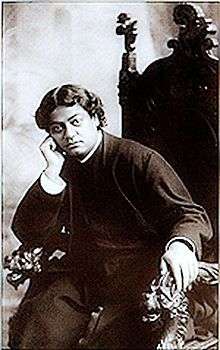
Public media like press and theatres became vents of nationalist sentiments, apolitical organisations had given way to political platforms, secret revolutionary societies emerged and the society at large became restive.
With rising nationalism among Bengalis, the British rulers applied divide and rule policy, and started to make favours to Bengali Muslims.[41] To keep the rising Bengali Hindu aspirations at bay, the British partitioned the province in 1905 and along with some additional restructuring came up with two provinces – Eastern Bengal & Assam and Bengal itself, in each of which the Bengali Hindus were reduced to minorities. The Bengalis, however, opposed to the Partition tooth and nail, embarked on a political movement of Swadeshi, boycott and revolutionary nationalism. On 28 September 1905, the day of Mahalaya, 50,000 Bengali Hindus resolved before the Mother at Kalighat to boycott foreign goods and stop employing foreigners.[42][43] The British Raj finally annulled the Partition in 1911. The Raj, however, carried out some restructuring, and carved out Bengali Hindu majority districts like Manbhum, Singbhum, Santal Pargana and Purnia awarding them to Bihar and others like Cachar that were awarded to Assam, which effectively made the Bengali Hindus a minority in the united province of Bengal. The Britishers also transferred the capital from Calcutta to New Delhi.
The revolutionary movement gained momentum after the Partition. Bengali revolutionaries collaborated with the Germans during the War to liberate British India. Later the revolutionaries defeated the British army in the Battle of Jalalabad and liberated Chittagong. During the Quit India Movement, the revolutionaries liberated the Tamluk and Contai subdivision of Midnapore district from British rule and established the Tamralipta National Government.
The British, unable to control the revolutionary activities, decided to hinder the Bengali Hindu people through administrative reforms. The Government of India Act 1919 introduced in the 144 member Bengal Legislative Assembly, 46 seats for the Muslims, 59 for the institutions, Europeans & others and left the rest 39 as General,[N 1] where the Bengali Hindus were to scramble for a representation. The situation worsened with the Communal Award of 1932, where in the 250 member Bengal Legislative Assembly a disproportionate 119 seats were reserved for the Muslims, 17 for Europeans, Anglo-Indians & Indian Christians, 34 for the institutions, and the rest 80 were left as General.[44] The Communal Award further divided the Hindus into Scheduled Caste Hindus and Caste Hindus.[44] Out of the 80 General seats, 10 were reserved for the Scheduled Castes.[N 2] In response the leading Bengali Hindu landholders, lawyers and professionals signed the Bengal Hindu Manifesto on 23 April 1932 rejecting the justification of reservation of separate electorates for Muslims in the Bengal Legislative Assembly.[45] Later in the year, the Muslim League government orchestrated the infamous Noakhali genocide.
After the failure of the United Bengal plan, it became evident that either all of Bengal would go to Pakistan, or it would be partitioned between India and Pakistan. Direct Action Day and the Noakhali genocide prompted the Bengali Hindu leadership to vote for the Partition of Bengal to create a Hindu-majority province.[46] On 23 April 1947, the Amrita Bazar Patrika published the results of an opinion poll, in which 98.3% of the Bengali Hindus favoured the creation of a separate homeland.[47][48] The proposal for the Partition of Bengal was moved in the Legislative Assembly on 20 June 1947, where the Hindu members voted 58–21 in favour of the Partition with two members abstaining.[N 3]
The Boundary Commission awarded the Bengali Hindus a territory far less in proportion to their population which was around 46% of the population of the province, awarding the Bengali Hindu majority district of Khulna to Pakistan. However, some Bengali Muslim majority districts such as Murshidabad and Malda were handed to India.
Post-partition period
After the Partition, the majority of the urban upper class and middle class Bengali Hindu population of East Bengal immigrated to West Bengal. The ones who stayed back were the ones who had significant landed property and believed that they will be able to live peacefully in an Islamic state. However, after the genocide of 1950, Bengali Hindus fled East Bengal in thousands and settled in West Bengal. In 1964, tens of thousands of Bengali Hindus were massacred in East Pakistan and most of the Bengali Hindu owned businesses and properties of Dhaka were permanently destroyed[49] During the liberation war of Bangladesh, an estimated 2.4 million Bengali Hindus were massacred in Bangladesh.[18] The Enemy Property Act of the Pakistan regime which is still in force in the new incarnation of Vested Property Act, has been used by successive Bangladeshi governments to seize the properties of the Hindu minorities who left the country during the Partition of India and Bangladesh liberation war. According to Professor Abul Barkat of Dhaka University, the Act has been used to misappropriate 2,100,000 acres (8,500 km2) of land from the Bengali Hindus, roughly equivalent to the 45% of the total landed area owned by them.[50]
In Assam's Brahmaputa Valley Bongal Kheda movement (which literally means drive out Bengalis) was happened in the late 1948-80s, where several thousands of Hindu Bengalis was massacred by jingoists Assamese nationalists mob in various parts of Assam and as a result of this jingoist movement, nearly 5 lakh Bengali Hindus were forced to flee from Assam to took shelter in neighbouring West Bengal particularly in Jalpaiguri division in seek for safety.[51][52][53] In the Barak Valley region of Assam, violence broke out in 1960 and 1961 between Bengali Hindus and ethnic Assamese police over a state bill which would have made Assamese mandatory in the secondary education curriculum. On 19 May 1961, eleven Bengali protesters were killed by Assamese police fired on a demonstration at the Silchar railway station.[54][55][56] Subsequently, the Assam government allowed Bengali as the medium of education and held it as an official position in Barak Valley.[55] The United Liberation Front of Asom, National Democratic Front of Bodoland, Muslim United Liberation Tigers of Assam and National Liberation Front of Tripura militants have selectively targeted the Bengali Hindu people, prompting the latter to form the Bengali Tiger Force.[57]
Discrimination against refugee Bengali Hindu population is not limited to the North East. In Odisha, in a family of ten individuals, only half of them has been recognised as Indians while the rest were branded as Bangladeshis.[58]
The Bengali refugees who had settled in Bihar after the partition of India are denied land owning rights, caste certificates and welfare schemes. However, the Nitish Kumar government had promised to solve this problems and also to raise the status of Bangla as a language in the state.[59]
Geographic distribution
Bengali Hindus constitute a minority ethnic group of the total population in both Bangladesh and India,[60] forming less than 10% of the population in both countries. From the sixties onward, like many other ethnic groups of India, many Bengali Hindus began to emigrate outside India, mostly to pursue higher studies or in search of lucrative careers. This gave rise to a sizeable expatriate Bengali Hindu population in many parts of the world.[61]
West Bengal
Hinduism have existed in Bengal before 16th century BC and by the third century, Buddhism has also gain popularity in Bengal. West Bengal was created in 1947 as an act of Bengali Hindu Homeland Movement to saveguard the political, economical and land owning rights of Bengali Hindus of undivided Bengal region and as a result predominantly Hindu majority West Bengal became a part of Indian union. The Bengali Hindus form a majority in West Bengal, with a population of 54,218,102 (59%) but a notable section of non Bengali Hindus exist among Marwaris, Biharis, Odias, Nepalis and other tribals numbering around 10,067,444 residing in the state just comprising 10.54% and together the Hindu population in West Bengal is 64,385,546 comprising both Bengali and non Bengali Hindus (although non Bengali Hindus have adopted Bengali culture and language) as of 2011.
Bangladesh
Hinduism has been existed in what is now called Bangladesh since the ancient times. In nature, the Bangladeshi Hinduism closely resembles the ritual and customs of Hinduism practiced in the Indian state of West Bengal, with which Bangladesh (at one time known as East Bengal) was united until the partition of India. While in Bangladesh, Bengali Hindus are the second largest community with a population of 12,301,331 (8.2%) as of 2011 by Bangladesh census report but distinct Hindu population also exist among indigenous tribes like Garo, khasi, jaintia, Santhal, Bishnupriya Manipuri, Tripuri, Munda, Oraon, Dhanuk etc. In terms of population "Bangladesh is the third largest Hindu populated country" in the world after India and Nepal.
Dhaka (capital of Bangladesh)
Before India became independent, the city of Dhaka (present capital of Bangladesh) had a significant number of Bengali Hindus at 42.8%, but their numbers have since considerably dwindled, being outnumbered by Bengali Muslims. Out of 21 million population of the city as far estimated by 2020, Bengali Hindus are at present the second largest community just after Bengali Muslims in Dhaka numbering around at 1,051,167 i.e. (5%) and are mainly concentrated in Shankhari Bazaar.
Indian States other than West Bengal
Assam
Bengali Hindus first came into Assam during the time of British era of 1826 from neighbouring Bengal region as colonial official workers, bankers, railway employees, bureaucrats and later on during the time Partition of Bengal in 1947 and third patches just arrived after Bangladesh liberation war of 1971 as refugees. Bengali Hindus are now the third largest community in Assam after Assamese Hindus and Bengali Muslims with a population of 4,368,784 comprising (14%) of state population as of 2011 census. They are concentrated in the Barak Valley region and the population of Bengali Hindus in Barak Valley is 1,812,141 making up 50% of the total population of the region and in Brahmaputra valley, their numbers are 2,556,643 respectively and are mainly concentrated in Hojai District where Bengali are spoken by 53% of the population, Goalpara District, Bongaigaon district, Barpeta District, Kamrup District, Darrang district and Dhubri District with percentage ranging 5%-10% in all those districts mentioned above. As per 2011 census Bengali speaking population of Assam is a little above 90.03 lakhs, which is about 29% of the total population of Assam. About 48.41% of the Bengali speaking people of Assam are Hindu by religion.
Jharkhand
The Bengali Hindus came into Jharkhand during colonial period, brought up by Britishers as colonial workers mainly from western part of Bengal. Although many parts of Jharkhand districts bordering with West Bengal have its own native Bengali population since time immemorial. In Jharkhand the Bengali Hindu population is over 2.5 million comprising 8.09% but the overall Bengali speaking population are slightly majority there and the percentage of Bengali speaking ranges from 38%-40% respectively after Hindi.
Tripura
In Tripura, Bengali Hindus form the majority due to immigration from neighbouring East Pakistan during 1947 and 1971 and as a result Tripura has become a Bengali majority state. Bengali Hindus comprise nearly 59.81% of the state population which is around 2.19 million and Bengali Muslims are 6 lakh 10 thousand comprising 9.61% of the state population putting overall Bengali speakers at 70% as of 2011, whereas native Tripuris are 30% of the state population which is around 1.2 million as of 2011.
Andaman and Nicobar islands
There is also a significant number of Bengali Hindus residing in the Andaman and Nicobar Islands, estimated approximately 100,000 comprising 26%-28% of the population. Bengali is also the most widely spoken language in the Andaman and Nicobar Islands, despite it lacking official status.
Outside Indian Subcontinent
UK has a huge portion of Bengali Hindu population. Former Cricketer Isa Guha and Rhona Mitra are prominent descendants of Bengali Hindu diaspora.
Culture

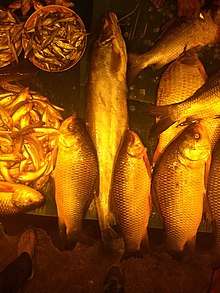
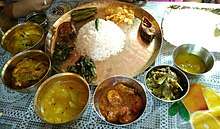
Economy
Bengali Hindu society used to be caste-oriented throughout centuries and the professional status of men depended exclusively on the hierarchical caste divisions. Some professions such as weaving, pottery, carpentry, blacksmithing etc. have always been carried out by special Hindu caste groups in Bengal. In traditional Bengali Hindu society, nearly every occupation is carried on by a ranked hierarchy of specialised caste groups- not only artisan occupations but also personal and domestic service functions such as barbering, laundering, latrine cleaning as well as non-menial tasks such as priesthood. However, with the introduction of British rule and appearance of urban civilisation, the former rural agrarian and artisan economy gradually crumbled and gave way to modern middle class economy. However, agriculture, land tenure, farming and fishing form the predominant economic activity in most of the rural area till now. A small but significant section of rural people carry out small trades and businesses. In urban and semi-urban areas, most of the people are engaged in business, industry, government and private service sectors, self-employing works and intellectual pursuits. Unemployment has persisted in a certain minuscule section of the community.
Literature
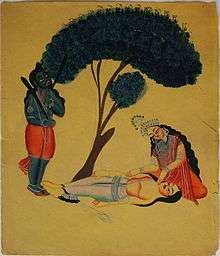
The proper Bengali literary history begins with the early Vaishnava literature like the Shreekrishna Kirtana and the Vaishnava padavalis followed by translation literatures like Ramayana and Srikrishna Vijaya. In the medieval period literary works on the life and teachings of Chaitanya Mahaprabhu were composed. This period saw the emergence of Shakta padavalis. The characteristic feature of Bengali Hindu literature in the middle age are the mangalkavyas, that glorify various Hindu gods and goddesses often using folkloristic backgrounds.
The early modern period saw a flurry in the literary activity especially after the emergence of the Bengali press. The first Bengali prose Raja Pratapaditya Charitra was written during this time. The Renaissance saw a rapid development in modern Bengali literature. Most of the epics, poems, novels, short stories and dramas of the modern classical literature were written during this period. The Bengal Literary Society that later came to be known as Bangiya Sahitya Parishad was founded. The literary development during the Renaissance culminated in Rabindranath's Nobel prize for literature.
In the Post-Partition period, the Bengali Hindus pioneered the Hungry generation, Natun Kabita and the little magazine movements. Of late, some of them have made their mark in contemporary English literature.
Art
The Kalighat school of painting flourished in Bengal in the early modern period, and especially after the first paper mill was set up in 1809. During the rise of nationalism in the early 20th century, the Bengali Hindus pioneered the Bengal school of art. It provided the artistic medium of expression to the Hindu nationalist movement. Though the Bengal school later gave way to modernist ideas, it left an enduring legacy. In the post-liberalisation phase of India, modern art acquired a new dimension as young artists like Devajyoti Ray, Sudip Roy and Paresh Maity started gaining international recognition. Devajyoti Ray is known for introducing Pseudorealism, which is one of the most original genres of Indian art today.
Religion
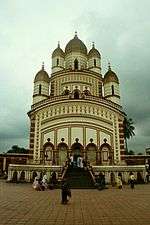
.jpg)
The Bengali Hindus generally follow the beliefs and practices that fall under the broad umbrella of Hinduism. Majority of them follow either the Shakta or the Vaishnava traditions, and some follow a synthesis of the two. The minor traditions include Shaiva etc. A significant minority is atheist who do not follow any rituals. Brahmoism is also found among Bengali Hindus.
A part of the parent tradition, the Bengali Hindus usually affiliate themselves to one of the many sects that have come to be established as institutionalised forms of the ancient guru-shishya traditions. Major amongst them include the Ramakrishna Mission, Bharat Sevashram Sangha, Bijoy Krishna Goswami, Anukul Thakur, Matua, ISKCON, Gaudiya Math, Ananda Marga, Ram Thakur etc.
Festivals
According to a famous Bengali proverb, there are thirteen festivals in twelve months ( বারো মাসে তেরো পার্বণ ). Bengali Hindus celebrate all major Indian festivals. The year begins with the Bengali New Year's Day or Pohela Boishakh which usually falls on 15 April. Traditional business establishment commence their fiscal year on this day, with the worship of Lakshmi and Ganesha and inauguration of the halkhata (ledger). People dress in ethnic wear and enjoy ethnic food. Poila Baishakh is followed by Rabindra Jayanti, Rath Yatra and Janmashtami before the commencement of the Pujas.
The puja season begins with the Vishwakarma Puja and is followed up by Durga Puja, the greatest and largest Bengali Hindu festival. It is commemoration of the victory that teaches none is good and none is evil. Each and every war starts, continues and ends with an objective to fulfill their own minimum demands that is required to exist. The defeated always have to accept the dictations of the victors and the defeated becomes free from the guilt of having defeated in the war and again both victors and defeated become friends. According to Chandi Purana, goddess Durga killed Mahishasura, the demon like asura and saved the devas. Rama the prince of Ayodhya invoked the blessings of goddess Durga in a battle against Ravana of Lanka. Durga Puja is the commemoration of Rama's victory over Ravana and it ends in Bijoya Dashami. Durga Puja is followed by Kojagari Lakshmi Puja, Kali Puja, Bhai phonta, Jagaddhatri Puja.
The winter solstice is celebrated a Paush Sankranti in mid January, followed by Netaji Jayanti and Saraswati Puja,a puja dedicated to Goddess of Knowledge and music Goddess Saraswati. The spring is celebrated in the form of Dolyatra or Holi. The year ends with Charak Puja and Gajan.
- Durga Puja, the largest festival of Bengali Hindus
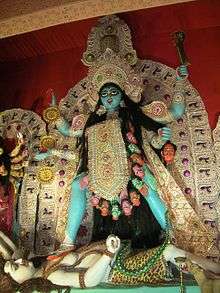 Kali Puja, a major festival of Bengal
Kali Puja, a major festival of Bengal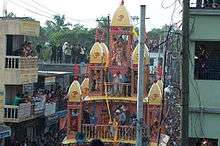 Rath Yatra at Dhamrai in Dhaka district, Bangladesh
Rath Yatra at Dhamrai in Dhaka district, Bangladesh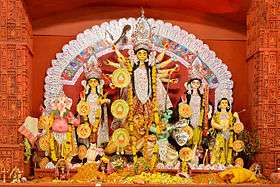 A traditional Durga idol
A traditional Durga idol The Bengali Hindu diaspora celebrate Durga Puja all over the world.
The Bengali Hindu diaspora celebrate Durga Puja all over the world.
See also
Notes
- There were no separate electorates for Hindus, in spite of them being minorities in the province.
- The Caste Hindus were supposed to contest in the 70 General seats. However as per the Poona Pact between Gandhi and Ambedkar, 20 General seats were reserved for Scheduled Castes.
- Rup Narayan Roy and Jyoti Basu, the two Communist Party MLAs abstained.
References
- "Bengal beats India in Muslim growth rate | India News - Times of India". The Times of India.
- "Scheduled Languages in descending order of speaker's strength - 2001". Registrar General and Census Commissioner of India. Archived from the original on 22 February 2013.
- Sanghamitra, Niyogi (2008). "Immigrant Sub-National Ethnicity: Bengali-Hindus and Punjabi-Sikhs in the San Francisco Bay Area". Paper Presented at the Annual Meeting of the American Sociological Association Annual Meeting, Sheraton Boston and the Boston Marriott Copley Place, Boston on 31 July 2008. Unpublished manuscript. Archived from the original on 7 July 2011. Retrieved 4 December 2010.
- "Population and Housing - Census 2011" (PDF). Bangladesh Bureau of Statistics. Archived from the original (PDF) on 3 September 2017. Retrieved 2 September 2019.
- "What Are London Kalibari's Aims for the Future?". London Kalibari. Retrieved 5 December 2010.
- The Australian people:an encyclopedia of the nation, its people and their origins. Cambridge University Press. 2001. p. 186. ISBN 9780521807890. Retrieved 6 December 2010.
- "Bengali" (PDF). Asia Harvest. Retrieved 31 March 2011.
- "Indian Associations and portals in Sweden". GaramChai.com. Retrieved 17 October 2010.
- "What Is Hinduism?", p. 27
- "The Home and the World", by Rabindranath Tagore, p. 320
- B.P. Syam Roy (28 September 2015). "Bengal's topsy-turvy population growth". The Statesman.
- Population by religious community: West Bengal. 2011 Census of India.
- "Historical Dictionary of the Bengalis", p. 351, by Kunal Chakrabarti, Shubhra Chakrabarti
- "Muslim freedom martyrs of India". Two Circles. Retrieved 26 December 2012.
- "Role of Muslims in the Freedom Movement-II". Radiance Weekly. Retrieved 26 December 2012.
- Roy, A. (1980). Genocide of Hindus and Buddhists in East Pakistan and (Bangladesh). Delhi: Kranti Prakashan. p. 94. OCLC 13641966.
- Brady, Thomas F. (5 April 1964). "Moslem-Hindu Violence Flares Again". The New York Times. New York. Retrieved 17 August 2014.
- Gumaste, Vivek. "The Hindu genocide that Hindus and the world forgot". India Tribune. Retrieved 1 March 2011.
- "Bangladesh war: The article that changed history – Asia". BBC. 25 March 2010.
- "Bangladesh sets up war crimes court – Central & South Asia". Al Jazeera. 25 March 2010. Archived from the original on 5 June 2011. Retrieved 23 June 2011.
- Wikipedia, Source (September 2013). University of Dhaka: 1971 Dhaka University Massacre, 1971 Killing of Bengali Intellectuals, Academic Divisions of University of Dhaka, Aparajeyo Bangl. General Books. ISBN 978-1-230-82794-0.
- Tagore, Rabindranath. "Atmaparichay". Society for Natural Language Technology Research. Archived from the original on 20 March 2012. Retrieved 8 June 2011.
- Garg, Ganga Ram (1992). Encyclopaedia of the Hindu world (Volume I). Concept Publishing Company. p. 3. ISBN 81-7022-374-1. Retrieved 5 June 2011.
- Sandipan Deb (30 August 2004). "In Apu's World". Outlook. Retrieved 12 March 2011.
- Ghosh, Shankha (2002). ইছামতীর মশা (Ichhamatir Masha). Swarnakshar Prakashani. p. 80.
- Ghosh, Sutama (2007). ""We Are Not All the Same":The Differential Migration, Settlement Patterns and Housing Trajectories of Indian Bengalis and Bangladeshis in Toronto" (PDF). Canada Mortgage and Housing Corporation. Retrieved 3 March 2011.
- "Bengali Hindu Migrant: Ashim Sen – Bradford". Bangla Stories. Retrieved 3 March 2011.
- Bose, Neilesh (2009). Anti-colonialism, regionalism, and cultural autonomy: Bengali Muslim politics, c.1840s – 1952 (PhD). Tufts University. Archived from the original on 17 August 2011. Retrieved 16 March 2011.
- Sarma, Jyotirmoyee (1980). Caste dynamics among the Bengali Hindus. Firma KLM.
- Sen, Dinesh Chandra (1999). Brihatbanga Volume I. Deys Publishing, p. 54.
- Bangali Charitabhidhan Volume I. Sansad, p. 341.
- "When he (Alexander) moved forward with his forces certain men came to inform him that Porus, the king of the country, who was the nephew of that Porus whom he had defeated, had left his kingdom and fled to the nation of Gandaridai... He had obtained from Phegeus a description of the country beyond the Indus: First came a desert which it would take twelve days to traverse; beyond this was the river called the Ganges which had a width of thirty two stadia, and a greater depth than any other Indian river; beyond this again were situated the dominions of the nation of the Prasioi and the Gandaridai, whose king, Xandrammes, had an army of 20,000 horse 200,000 infantry, 2,000 chariots and 4,000 elephants trained and equipped for war".... "Now this (Ganges) river, which is 30 stadia broad, flows from north to south, and empties its water into the ocean forming the eastern boundary of the Gandaridai, a nation which possesses the greatest number of elephants and the largest in size." –Diodorus Siculus (c.90 BC – c.30 BC). Quoted from The Classical Accounts of India, Dr R.C. Majumdar, p. 170-72/234
- Gangaridai#During Alexander's invasion
- Sarkar, Jagadish Narayan (1981). Banglay Hindu-Musalman Samparka (Madhyayuga). Kolkata: Bangiya Sahitya Parishad. p. 53.
- "When the Islamic missionaries arrived they found in several instances that the conquering armies had destroyed both the temples of revived Hinduism and the monasteries of the older Buddhism; in their place—often on the same sites—they built new shrines. Moreover, they very frequently transferred ancient Hindu and Buddhist stories of mir. Quoted in The Interaction of Islam and Hinduism. Retrieved 9 September 2015.
- Chaudhuri, B.B. (2008). Peasant history of late pre-colonial and colonial India. Pearson Education India, p. 184.
- Kumar, Dharma; Desai, Meghnad, eds. (1983). The Cambridge Economic History of India. Volume 2: c. 1757—c. 1970. Cambridge University Press. p. 299. ISBN 978-0-521-22802-2.
- Sengupta, Nitish K. (2001). History of the Bengali-speaking people. New Delhi: UBS Publishers' Distributors. ISBN 81-7476-355-4. OCLC 49326692.
- Sinha, Narendra Krishna (1967). The History of Bengal, 1757-1905. University of Calcutta.
- Bangali Charitabhidhan Volume I. Sansad, p. 489.
- Novak, James Jeremiah (1 January 1993). Bangladesh: Reflections on the Water. Indiana University Press. p. 140. ISBN 978-0-253-34121-1.
- Das, S.N.(ed). The Bengalis: The People, their History and Culture. Genesis Publishing, p. 214.
- Beck, Sanderson. Ethics of Civilization Volume 20: South Asia 1800–1950. World Peace Communications
- Government of India Act, 1935, 26 GEO. 5. CH. 2., Fifth Schedule, p. 245.
- Mitra, N.N.(ed), Indian Annual Register, Volume I, Jan–Jun 1932, p. 323.
- Fraser, Bashabi; Sengupta, Sheila, eds. (2008). Bengal Partition Stories: An Unclosed Chapter. Anthem Press. pp. 25–26. ISBN 978-1-84331-225-3.
- Roy, Haimanti (2009). A Partition of Contingency? Public Discourse in Bengal, 1946–47. Cambridge University Press, p. 2.
- Roy, Tathagata. My People, Uprooted. Ratna Prakashan, p. 131.
- Ghosh Dastidar, Sachi (2008). Empire's Last Casualty: Indian Subcontinent's vanishing Hindu and other Minorities. Kolkata: Firma KLM. pp. 131–134. ISBN 978-81-7102-151-2.
- Barkat, Abul; Zaman, Shafique uz; Khan, Md. Shahnewaz; Poddar, Avijit; Hoque, Saiful; Uddin, M Taher (February 2008). Deprivation of Hindu Minority in Bangladesh: Living With Vested Property. Dhaka: Pathak Shamabesh. pp. 73–74.
- https://www.aljazeera.com/amp/indepth/features/foreigners-means-bengali-india-assam-200224111340521.html
- https://www.outlookindia.com/magazine/story/india-news-opinion-antipathy-towards-bengalis-prime-mover-of-assam-politics/302538
- https://www.asianage.com/amp/opinion/columnists/171219/assam-protests-due-to-politics-of-xenophobia.html
- Baruah, Sanjib (1999). India Against Itself: Assam and the Politics of Nationality. University of Pennsylvania Press. p. 105. ISBN 0-8122-3491-X.
The most notorious 'language riots' in Assam were in 1960 and 1961, before and after the passing of the Official Language Bill by the state Assembly ... There were violent conflicts between ethnic Assamese and Hindu Bengalis ... On the Bengali side, for instance, Paritosh Pal Choudhury's book Cacharer Kanna (The Cry of Cachar) has a frontispiece with pictures of eleven garlanded dead bodies of people killed in 1961 as a result of police firing on a demonstration in support of Bengali in Silchar.
- "Silchar rly station to be renamed soon". The Times of India. Silchar. 9 June 2009. Retrieved 30 November 2010.
- Ganguly, M. (20 May 2009). "All for love of language". The Telegraph. Ranchi. Retrieved 30 November 2010.
- "Now Bengali militants raise heads in Assam". The Indian Express. India. 18 August 1998. Retrieved 30 November 2010.
- "Indians, Bangladeshis in same Orissa family!". The Indian Express. Kendrapara. 29 January 2009. Archived from the original on 13 January 2012. Retrieved 30 November 2010.
- Kumar, Madhuri (26 October 2010). "JD(U) Bangla bait for Bengalis in Bihar". The Times of India. Patna. Retrieved 30 November 2010.
- Togawa, Masahiko (2008). "Hindu Minority in Bangladesh – Migration, Marginalization and Minority Politics in Postcolonial South Asia" (PDF). Discussion Paper Series. Hiroshima University. 6: 2. Archived from the original (PDF) on 22 July 2011. Retrieved 12 March 2011.
- Roy, Tathagata (2002). My people uprooted: a saga of the Hindus of eastern Bengal. Ratna Prakashan. ISBN 978-81-85709-67-3.
Bibliography
- Ray, Nihar Ranjan (2009). Bangalir Itihash (Adi Parva). Dey's Publishing.
- Bandyopadhyay, Rakhaldas (2008). Bangalar Itihash. Dey's Publishing. ISBN 81-7079-866-3.
- Sen, Dinesh Chandra. Brihatbanga.
- Mitra, Satish Chandra. Jashor Khulnar Itihash.
- Ghosh, Binoy. Paschimbanger Sanskriti.
- Inden, Ronald B., Nicholas, Ralph W. (2005). Kinship in Bengali Culture. DC Publishers. ISBN 81-8028-018-7.
- Bhattacharya, S.K. (1987). Genocide in East Pakistan/Bangladesh. A Ghosh. ISBN 0961161434.
- Kamra, A. J. Prolonged Partition and its Pogroms. Voice of India.
- Roy, Tathagata. My People, Uprooted. Ratna Prakashan.
- Bando, Ramen (2004). Ethnic Cleansing in Bangladesh. CAAMB.
- Pramanik, Bimal (2005). Endangered Demography. G.C. Modak.
- Dastidar, Sachi G (2008). Empire's Last Casualty: Indian Subcontinent's vanishing Hindu and Other Minorities. Firma KLM. ISBN 81-7102-151-4.
- Sengupta, Nitish (2002). History of the Bengali-Speaking People. UBS Publishers. ISBN 81-7476-355-4.
